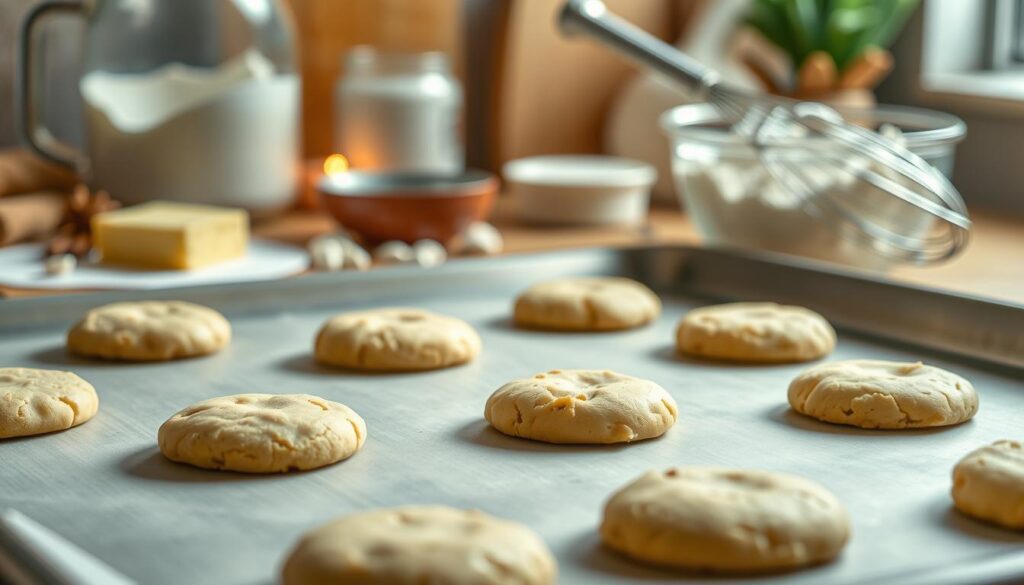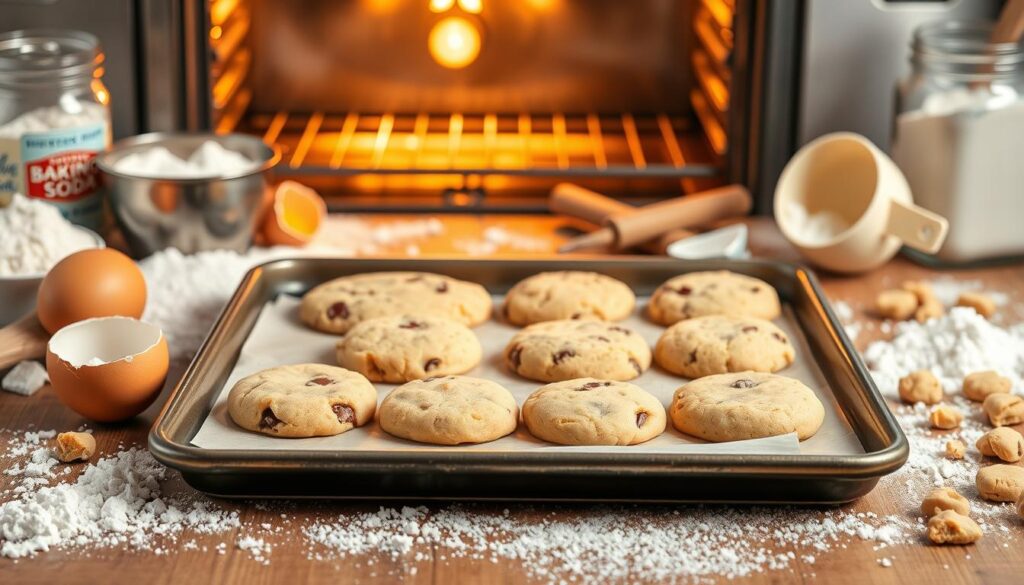Baking the perfect cookie can be tough, especially when they turn out flat. Many bakers, new or experienced, struggle to get their cookies thick and chewy. Mistakes in the baking process often cause these issues, affecting the cookie’s texture.
This article will explore the science behind baking cookies. We’ll share important tips to help you make thick, chewy cookies. We’ll look at ingredient measurement, oven temperature, and the best cookie recipes, like the Nestle chocolate chip cookie recipe. Get ready to improve your baking by learning why cookies go flat and how to fix it!

Key Takeaways
- Properly measuring ingredients is essential to avoid flat cookies; too much sugar or too little flour can lead to excessive spreading.
- Chilling cookie dough before baking can significantly reduce cookie spread and help maintain thickness.
- Using the right fat as specified in the recipe is critical; substitutions can alter texture and spreading characteristics.
- Room temperature butter, around 65°F, is optimal for achieving the desired air incorporation during creaming.
- Oven temperature accuracy can prevent cookies from melting too quickly; consider investing in a digital oven thermometer.
- Avoid greasing cookie sheets; utilize parchment paper or silicone mats for consistent results without excess spread.
- Technique matters; proper mixing methods can make a significant difference in your cookie’s rise and overall texture.
The Science of Cookie Baking
Understanding cookie chemistry is key to baking great treats. Each ingredient in cookie recipes is crucial. They affect the cookie’s texture and taste through complex interactions. For example, moisture turns into steam, which helps dough rise and leaven.
The baking science behind cookies stresses the importance of exact measurements. Small changes in flour to sugar ratios can greatly impact the cookie. Too little flour can cause cookies to spread too much. Too much sugar can make them flat.

Butter, eggs, and leavening agents like baking powder and soda are important for rising. Overmixing dough can make cookies thin and crispy. It’s best to chill the dough for at least two hours to prevent spread during baking.
- Chilling for 20 minutes results in noticeable spread compared to an hour in the fridge.
- Lower baking temperatures lead to cookies that are puffier and paler due to slower drying.
- Using parchment paper often yields better cookie spread than silicone baking mats.
Every part of cookie ingredients is vital for perfect cookies. Learning the science of baking helps you enjoy and recreate the amazing textures and tastes of cookies.
Common Causes for Flat Cookies
Understanding why cookies turn out flat is key to baking success. Many mistakes can lead to flat cookies. These include wrong measurements, oven temperature errors, and bad ingredient choices.
Butter’s role is crucial; it should be around 65 degrees Fahrenheit. If it’s too soft, cookies spread too much. Also, high oven temperatures can flatten cookies before they rise. A digital oven thermometer ensures the right temperature.
Not chilling cookie dough enough is another common mistake. Chilling it for at least 30 minutes helps prevent spreading. Using hot or greased baking sheets also causes issues. It’s better to cool sheets between batches and use silicone mats or parchment paper.
Getting the right mix of ingredients is vital. Too little flour or too much sugar can make cookies flat. Recipes with granulated sugar spread more than those with confectioners’ sugar. Accurate measurements are crucial for the right cookie structure.
Finally, keep cookies two inches apart on baking sheets. Crowding leads to spreading and disappointing results. Understanding these causes helps bakers improve their baking skills.

| Cause | Description |
|---|---|
| Too Soft Butter | Can lead to excessive spreading during baking. |
| Incorrect Oven Temperature | Should be checked with a thermometer to avoid flat cookies. |
| Over-Greasing Baking Sheets | Prevents cookies from holding their shape. |
| Inaccurate Ingredient Measurements | Too much sugar or too little flour can cause flattening. |
| Failure to Chill Dough | Not allowing dough to rest can increase spreading. |
| Improper Mixing Techniques | Overmixing or undermixing can compromise cookie texture. |
| Expired Ingredients | Using old baking powder or soda can negatively affect rise. |
Why Do My Cookies Go Flat After Baking?
Understanding why cookies go flat is key to improving your baking. Several factors cause flat cookies, with oven temperature being a major one. The temperature affects how much cookies spread during baking.
Oven Temperature Issues
Oven temperature greatly impacts cookie height and texture. Baking at too high a temperature can melt fats too quickly, causing cookies to spread too much. On the other hand, baking at too low a temperature can make cookies spread too much because they don’t set right. Using an oven thermometer helps ensure the right temperature for baking.
Impact of Ingredients on Cookie Texture
Ingredients play a big role in cookie texture, not just the amounts. The ratio of flour to sugar, for example, affects how much cookies spread. Too much flour or sugar, especially white sugar, can make cookies flat. It’s important to balance these ingredients well. Also, using room temperature butter can make cookies spread too much. Chilled or melted butter, however, can help improve their texture.
How to Measure Ingredients Correctly
Getting the right measurements is key to making great cookies. If you measure wrong, your cookies might not turn out right. Learning how to measure ingredients well can make a big difference.
The Importance of Accurate Measurements
When measuring cookie ingredients, using the right amounts is crucial. This ensures the right mix of flour, sugar, and fat. If you get this wrong, your cookies might spread too much or not rise at all.
Too much sugar can make cookies spread instead of rising. And using the wrong amount of flour can also make them flat. Paying close attention to these measurements can improve both the texture and taste of your cookies.
Using Scales vs. Measuring Cups
For the most accurate baking, baking scales are the best choice. They give you the exact weight of dry ingredients, which is vital for baking success. If you prefer using measuring cups, make sure to use a large spoon to scoop flour and then level it off with a knife.
Here’s a quick comparison of both methods:
| Method | Advantages | Disadvantages |
|---|---|---|
| Baking Scales | Exact weight for precise measurements | Requires an extra tool |
| Measuring Cups | Readily available and easy to use | Can lead to inaccuracies if not leveled correctly |
Both methods can help you make great cookies if done right. It’s important to focus on getting your measurements accurate. This will greatly affect how your cookies turn out.
The Role of Butter in Cookie Baking
The type of butter used in baking greatly affects cookie results. Knowing the difference between softened and melted butter is key. This choice impacts how cookies rise and spread, changing their flavor and texture.
Softened vs. Melted Butter
Softened butter should be pliable but not too squishy. It should be left at room temperature for 30 to 60 minutes. Melted butter, however, adds more liquid, making cookies flat and denser.
Experts recommend using the fat type called for in the recipe. Different fats melt at different rates, affecting cookie texture.
Temperature Effects on Butter
The butter’s temperature affects cookie dough’s performance. Beating butter and sugar too long can make cookies too puffy or dry. This is because too much air gets mixed in.
It’s important to measure ingredients correctly. Using expired baking powder or wrong sugar amounts can ruin cookie texture. Make sure baking sheets aren’t too greasy to keep cookies in shape.
Chilling dough for at least two hours helps. It balances fat and flour, improving cookie texture.
Importance of Chilling Dough
Chilling cookie dough is key to getting the perfect cookies. It makes cookies thicker and chewier, not flat. Knowing how chilling affects baking and using good tips can make your cookies better.
How Chilling Affects Cookie Spread
Chilling cookie dough has many benefits. It makes cookies less spread and thicker. Chilling for at least 30 minutes helps prevent over-browning and improves texture.
- The longer the dough is chilled, the better the color and flavor.
- Cookies made right after mixing are soft, unlike chilled ones which are crisp.
- Chilling for at least 30 minutes makes a big difference.
- Sugars absorb liquid and flour breaks down, making the dough sweeter and more flavorful.
Chilling for 24 to 72 hours is best for flavor. Freezing dough after 24 hours keeps it moist. But, oatmeal dough should not chill for more than 48 hours to stay moist.
Fats in butters like Kerrygold need careful chilling. This prevents cookies from spreading too fast. Chilling slowly helps cookies keep their shape. Recipes for chocolate chip, shortbread, sugar, and ginger cookies all benefit from chilling. Following these tips will make your cookies delicious every time.
| Chilling Duration | Effects on Cookies |
|---|---|
| 30 Minutes | Reduces spread and browning significantly. |
| 2 Hours | Enhances flavor, yields a crispy edge with optimal spread. |
| 24-48 Hours | Improves taste and texture; allows for deeper flavor development. |
| 72 Hours | Diminishing returns; possible dryness after extended chilling. |
Using the Right Baking Sheets
Choosing the right baking sheets for cookies is key to great results. The type and treatment of the sheets affect how cookies spread. Knowing the differences can help you bake better.
Greased vs. Ungreased Baking Sheets
Greased and ungreased sheets change cookie texture a lot. Greased sheets make cookies spread too much. Ungreased sheets or those with parchment paper help cookies keep their shape.
Greasy sheets can make cookies flatten too much. For the best results, lightly grease the sheets. This balances sticking and spreading.
Using Parchment Paper vs. Silpat
Parchment paper and Silpat mats are both popular for baking. But they affect cookies slightly differently. Parchment paper helps cookies stay consistent and spread less.
Silpat mats might let cookies spread a bit more. The choice between them can change how cookies look and feel. Using these materials right can improve cookie quality. Remember to leave space between cookies for them to spread properly.
| Type of Baking Sheet | Effect on Cookies | Recommendation |
|---|---|---|
| Greased Baking Sheet | May cause excessive spreading, resulting in flat cookies. | Use lightly greased for better results. |
| Ungreased Baking Sheet | Promotes slower spreading and helps maintain cookie shape. | Ideal for crispy cookies. |
| Parchment Paper | Non-stick, gives consistent texture, helps in uniform baking. | Great for all cookie types. |
| Silpat Mat | Encourages slight spreading due to silicone coating. | Perfect for softer cookies. |
Mixing Techniques That Influence Cookies
Knowing the right cookie mixing techniques is key to perfect cookies. Mixing dough the right way can make a big difference. Overmixing and creaming butter correctly are both important. Let’s dive into how these steps help make great cookies.
Avoiding Overmixing
Overmixing dough is a common error that can mess up cookies. It makes the dough tough and dry, ruining the texture. It’s vital to mix just enough to combine the ingredients. Here are some tips to avoid overmixing:
- Avoid adding too many ingredients, which can weigh down the dough.
- Use a light hand when mixing to maintain a tender cookie.
- Chilling the dough before baking can help prevent excessive spreading.
Proper Creaming Techniques
Creaming butter correctly is crucial for the right texture. It adds air to the dough, making cookies rise and stay soft. Here’s how to cream butter properly:
- Start with softened butter for better incorporation with sugar.
- Beat the butter and sugar just until it’s light and fluffy to incorporate air.
- Maintain a consistent fat-to-flour ratio for optimal cookie structure.
In summary, mastering mixing techniques greatly improves cookie baking. Using the right cookie mixing techniques and avoiding overmixing and improper creaming will give you delicious cookies every time.
Best Baking Practices for Thick, Chewy Cookies
To get perfect thick chewy cookies, pay close attention to spacing and recipe choice. Good baking practices can make your cookies both tasty and textured.
Proper Spacing on Baking Sheets
Spacing cookies correctly on baking sheets is key. Keep at least two inches between each cookie. This lets them spread evenly and cook well.
Remember, cookies will grow as they bake. If they’re too close, they won’t spread right. This can make them too flat.
Following Tried and True Recipes
Using trusted cookie recipes is crucial for consistent results. Recipes like the Nestle chocolate chip cookie have been perfected for texture and taste. They have the right mix of ingredients for chewy cookies.
Choosing proven recipes saves you from trial and error. It ensures your cookies turn out delicious every time.
| Aspect | Recommendation |
|---|---|
| Cookie Spacing | At least 2 inches apart |
| Reliable Recipes | Use well-tested cookie recipes |
| Baking Sheets | Parchment-lined aluminum for even baking |
| Baking Temperature | Verify with an oven thermometer |
| Dough Preparation | Chill and properly measure ingredients |
Conclusion
Getting perfect cookies is all about knowing the right baking techniques and using the right ingredients. This summary has shown why cookies might turn out flat, like oven temperature problems and ingredient effects. It’s key to remember that following a recipe is just the start.
Most cookie recipes don’t tell you how to bake them right. For example, 72% of chocolate chip cookie recipes skip over these important steps. This can lead to cookies that don’t turn out well, even if you follow the recipe exactly.
To get better at baking, use the detailed baking tips from this article. Make sure your butter is at the right temperature and measure your ingredients carefully. Also, chilling your cookie dough can help control how spread out they get.
With 58% of bakers struggling, using these tips can make a big difference. Focusing on technique, not just ingredients, will help you make better cookies.
Now is the time to try out different cookie recipes with the tips you’ve learned. Remember, making great cookies takes knowledge, attention to detail, and a willingness to make changes. Start your baking journey and see your cookies become amazing treats that everyone will love.
FAQ
What causes cookies to flatten during baking?
Cookies can flatten for several reasons. These include wrong oven temperature and bad ingredient measurements. The type of baking sheet used also matters.
Not chilling the dough enough or greasing the sheets too much can also cause flat cookies.
How can I ensure my cookies are thick and chewy?
For thick and chewy cookies, start with precise measurements. Make sure the dough is chilled. Avoid using melted butter.
Also, space cookies well on baking sheets. Stick to trusted recipes, like the Nestle chocolate chip cookie recipe.
Why is measuring ingredients accurately important in baking?
Measuring ingredients right is key in baking. Wrong measurements can mess up the ratio of ingredients. This affects the cookie’s texture.
Using a kitchen scale helps keep things consistent and precise.
What happens if I use melted butter instead of softened butter?
Melted butter makes cookies spread too much, leading to flatness. Softened butter is better because it adds air to the dough. This helps cookies rise better.
How does chilling dough affect cookie baking?
Chilling dough makes the fats solid, slowing their melting in the oven. This helps cookies keep their shape and become thicker. Chill the dough for at least two hours or overnight for the best results.
Are certain baking sheets better for cookies?
Yes, ungreased baking sheets or those with parchment paper or Silpat mats are best. They prevent cookies from spreading too much. These surfaces also help with even heat and browning.
What baking techniques should I avoid to prevent flat cookies?
To avoid flat cookies, don’t overmix the dough. This introduces too much air, causing cookies to collapse. Also, don’t skip proper creaming techniques. It’s essential for the right texture.
What are common baking mistakes that lead to flat cookies?
Common mistakes include wrong ingredient measurements and oven temperatures. Using the wrong butter type is another error. Not chilling the dough and greasing sheets too much also cause flat cookies.
